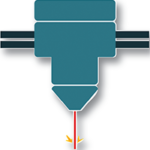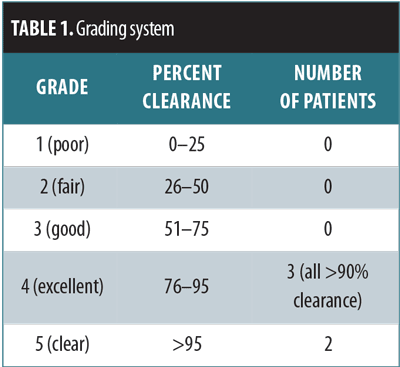 by Brian Tian, MBBS, Dip Derm
by Brian Tian, MBBS, Dip Derm
Dr. Tian is with Singapore General Hospital, Singapore.
J Clin Aesthet Dermatol. 2017;10(8):28–30
Funding: No funding was provided for this study.
Disclosures: The author has no conflicts of interest relevant to the contents of this article.
Keywords: Ephelides, freckles, Asian, Erb:YAG, erbium
Abstract: Objective. The purpose of this study was to demonstrate a novel, effective, and safe way to utilize the Erb:YAG laser to clear freckles in Type III/IV Asian skin.
Design. This was a prospective study. Setting: The setting was a Singapore-based clinic.
Participants. Participants included five women, aged 25 to 38 years, three with Skin Type III and two with Skin Type IV. All of them had freckles.
Measurements. Photographs were taken pretreatment and one month after laser treatment. Three independent physicians evaluated the photographs using a grading system. Patients were followed clinically for a total of six months post-laser treatment to monitor for post-inflammatory hyperpigmentation and recurrence.
Results. At one month post-laser treatment, all five patients were evaluated. The three independent physicians agreed that all five patients had greater than 90-percent clearance of their freckles. During the subsequent follow-up visits (up to 6 months post-laser treatment), no post-inflammatory hyperpigmentation, hypopigmentation, or recurrence was seen.
Conclusion. The Erb:Yag laser might be considered an effective and safe treatment for freckles in Asian patients.
Introduction
Freckles (ephelides) are small brown macules that appear on sun-exposed areas. Previously, treatments for freckles included dermabrasion, electrodessication, and chemical peeling.[1] These treatments can cause scarring, among other undesirable side effects. In the past decade, freckles have been reported to significantly lighten and clear with Q-switched (QS) Alexandrite (QSAL) and QS Nd:YAG lasers.[2,3] In 2000, Jang et al[2] reported the use of a QSAL for freckles in 197 Korean patients, all of whom experienced at least 76-percent clearance after an average of 1.5 treatments. Rashid et al[3] also showed that a 532nm QS Nd:YAG laser could achieve 50-percent improvement in 14 patients with freckles. While these are good results, there is still a need for a laser technique that can achieve close to 100-percent clearance in as short a time as possible, with minimal treatment sessions and minimal to zero complications. Freckles (ephelides) are small brown macules that appear on sun-exposed areas. Previously, treatments for freckles included dermabrasion, electrodessication, and chemical peeling.[1] These treatments can cause scarring, among other undesirable side effects. In the past decade, freckles have been reported to significantly lighten and clear with Q-switched (QS) Alexandrite (QSAL) and QS Nd:YAG lasers.[2,3] In 2000, Jang et al[2] reported the use of a QSAL for freckles in 197 Korean patients, all of whom experienced at least 76-percent clearance after an average of 1.5 treatments. Rashid et al3 also showed that a 532nm QS Nd:YAG laser could achieve 50-percent improvement in 14 patients with freckles. While these are good results, there is still a need for a laser technique that can achieve close to 100-percent clearance in as short a time as possible, with minimal treatment sessions and minimal to zero complications.
In this brief report, we present a study of five Chinese patients (Skin Types III/IV) whose freckles cleared greater than 90 percent following one treatment session using a fractional 2940nm nonablative Erb:YAG micropeel laser.
Methods and Materials
Five Chinese patients with freckles were recruited over the course of two months. All five patients were women, with ages ranging 25 to 38 years— three with Skin Type III and two with Skin Type IV. These patients were otherwise in good health. Those with melasma and those who had major sun exposures or other major skin conditions were excluded from the study. Patients who used any topical bleaching creams (hydroquinone) and those who received laser treatment within the past one year were all excluded. This small study was in accordance with the Helsinki Declaration, as revised in 2013. All patients consented to participate in the study. The patient depicted in the figures contained herein consented to the publication of her photos.
The fractional nonablative 2940nm Erb:YAG laser (SP Spectro, Fotona, Ljubljana, Slovenia) was operated at a fluence of 0.7J/cm2, spot size 12mm, 15Hz. A single full-face pass with 10-percent overlap was performed. Subsequent second and third passes were performed over the freckled areas until a clinical endpoint of skin whitening was achieved; no wiping was performed between the passes. Care was taken to keep the skin cool during the laser irradiation with cryogen spray cooling. Post-laser treatment, patients applied a topical antibiotic (fusidic acid) for three days and wore sunscreen during the daytime for the study duration.

Photographs were taken pretreatment and one month after laser treatment. Three independent physicians evaluated these photographs using the grading system shown in Table 1.[4] Patients were followed clinically for a total of six months post-laser treatment to monitor for post-inflammatory hyperpigmentation and recurrence.
Results
During the procedure, all patients tolerated mild-to-moderate pain without use of anesthesia. For 5 to 7 days post-laser treatment, there was notable erythema and scaling of the skin. All five patients noted lightening of their freckles at the end of 5 to 7 days, along with resolution of the skin peeling. At one month post-laser treatment, all five patients were evaluated. The three independent physicians agreed that all five patients had greater than 90-percent clearance of their freckles (Figures 1 and 2). During the subsequent follow-up visits (up to 6 months post-laser treatment), no post-inflammatory hyperpigmentation, hypopigmentation, or recurrence was observed.


Discussion
Superficial pigmented lesions, such as freckles, respond to a variety of lasers.[1] The most commonly used lasers are the pigment lasers, namely the frequency-doubled QS Nd:YAG, QS ruby, QSAL, and pulsed dye green laser. These lasers work by targeting melanin. By having wavelengths in the 400 to 600nm range and a short pulse duration, these lasers cause melanosome rupture, hence freckle lightening.[4–6]
Conversely, ablative lasers, such as the CO2 laser, have been used to nonspecifically damage the epidermis to remove pigmented lesions.[7] The advantage of CO2 is that it achieves a very good clearance rate with one or two sessions. However, the downtime thereafter can stretch up to two weeks or more post-laser treatment. There is also a risk of textural changes or scarring.[7]
To the best of our knowledge, treatment of freckles with the fractional 2940nm nonablative Erb:YAG laser has not been described. Moreover, minimal data on the treatment of freckles in Asian Type III/IV skin exist.
Limitations. We acknowledge that this study is too small to draw firm conclusions. A prospective study with a greater number of subjects is needed. It is important to replicate the results on a larger scale. More studies are needed to validate the proposed mechanism of action. More studies are also necessary to determine the optimal settings and techniques to be applied.
Conclusion
We demonstrated the Erb:YAG laser to be an effective treatment option for treatment of freckles using a single treatment session, which carries less risk and shorter down time compared to CO2 lasers. By using nonablative fractional settings, the Erb:YAG laser is able to ablate the epidermis partially. Freckles exist at the dermo-epidermal junction. At areas of partial ablation, these pigments can be removed immediately or extruded subsequently. Concurrently, there is coagulation of the upper dermis, which contributes to brightening and tightening of the face.[8–10] Although this system works in a similar fashion to the CO2 laser, the gentler nonablative settings ensure faster recovery (5–7 days) with less risk of PIH and scarring.
In conclusion, the 2940nm Erb:YAG laser might be considered an effective and quick modality for removing freckles without scarring or causing permanent pigmentary changes in Asian skin.
References
- Grevelink JM, Ross EV, Anderson RR. Lasers in dermatology. In: Freedberg IM, Eisen AZ, Wolff K, et al, eds. Fitzpatrick’s Dermatology in General Medicine. 5th ed. New York: McGraw-Hill, 1999:2901–2921.
- Jang KA, Chung EC, Choi JH, et al. Successful removal of freckles in Asian skin with a Q-switched alexandrite laser. Dermatol Surg. 2000;26:231–234.
- Rashid T, Hussain I, Haider M, Haroon TS. Laser therapy of freckles and lentigines with quasi-continuous, frequency-doubled, Nd:YAG (532 nm) laser in Fitzpatrick skin type IV: a 24-month follow-up. J Cosmet Laser Ther. 2002;4:81–85.
- Hruza GJ, Dover JS, Flotte TJ, Goetschkes M, Watanabe S, Anderson RR. Q-switched ruby laser irradiation of normal skin: histologic and ultrastructural findings. Arch Dermatol. 1991;127:1799–1805.
- Watanabe S, Flotte TJ, Margolis R, et al. The effect of pulse duration on selective pigment cell injury by dye lasers. Invest Dermatol. 1987;88:523.
- Kilmer SL, Wheeland RG, Goldberg DJ, Anderson RR. Treatment of epidermal pigmented lesions with the frequency-doubled Q-switched Nd:YAG laser. Arch Dermatol. 1994;130:1515–1519.
- Dover JS, Smoller BR, Stern RS, Rosen S, Arndt KA. Low-fluence carbon dioxide laser irradiation of lentigenes. Arch Dermatol. 1988;124:1219–1224.
- Christian MM. Microresurfacing using the variable-pulse erbium:YAG laser: a comparison of the 0.5- and 4-ms pulse durations. Dermatol Surg. 2003;29:605–611.
- Grema H, Greve B, Raulin C. Facial rhytides–subsurfacing or resurfacing? A review. Lasers Surg Med. 2003;32:405–412.
- Kunzi-Rapp K, Dierickx CC, Cambier B, et al. Minimally invasive skin rejuvenation with Erbium:YAG laser used in thermal mode. Lasers Surg Med. 2006;38:899–907.

